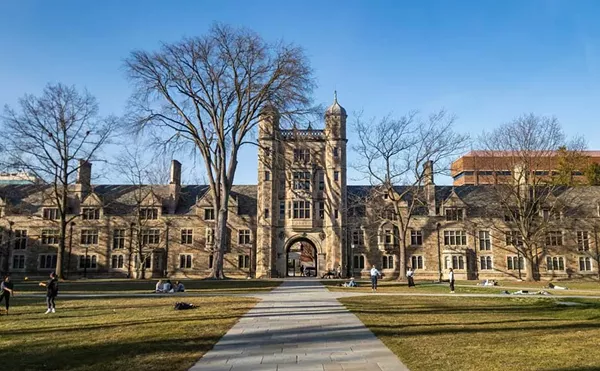In her survey of recent achievements in film, Susan Sontag declared, “Iranian cinema has been the great revelation of the last decade.” Surely one of those largely responsible for this phenomenon is the screenwriter and director Abbas Kiarostami.
Born in Tehran in 1940, Kiarostami worked as a commercial artist and children’s book illustrator until he was invited to lead the department of cinema at the Institute for the Intellectual Development of Children and Young Adults. Given this background, it’s not surprising that many of his projects feature children.
The White Balloon (1995), written by Kiarostami and directed by Jafar Panahi, tells the story of a strong-willed young girl who wants to purchase a goldfish (the traditional symbol of good luck) for the New Year’s celebration. Her mother cannot understand why she can’t simply catch one from the pool in their courtyard, but the girl has set her heart on one she has seen in a shop window, a fat one that’s “white as a bride,” with fins like veils and that moves like a dancer.
Finally relenting, mom provides the needed cash, but her daughter can’t seem to hang on to it. Moments after leaving home, she’s conned by two disreputable snake charmers, only to regain her money and then lose it again beneath a grate in the street.
An older woman tries to help her, telling her not to worry as she’ll inform the girl’s mother that it wasn’t her fault. Perplexed, the girl asks, “Whose fault is it then, if not mine?” Slightly exasperated, the woman responds, “Actually, it is your fault, but I’ll just tell her that to calm her down.”
Time runs short and many more frustrations must be endured before the film can end happily, as it must. With its heroine’s guileless honesty and purity of spirit, The White Balloon offers a trip back to childhood, when small things loomed large, deceit and malice were unthinkable, and the world was an enormous and overwhelming place.
Life and Nothing More(1992) (sometimes translated as And Life Goes On) was written and directed by Kiarostami, and takes place after a terrible earthquake. The story concerns a film director traveling through the countryside with his young son, attempting to reach the village where he had previously shot a film entitled Where is the Friend’s House? in order to determine the status of the children who were featured in the film.
Like most of Kiarostami’s films, the subject matter here is taken from actual experience. In fact, Kiarostami actually did direct a film called Where Is My Friend’s House? (1986). And in Through the Olive Trees (1994) he refers back to characters who appeared in Life and Nothing More. Such dizzying self-referentiality can be typical of Kiarostami’s modus operandi, yet each film stands on its own, and such games never detract from the existential dilemmas that confront his characters.
The typical Kiarostami film begins as nothing more than a brief outline, which he expands upon during the process of shooting. Thus, most of his films have a searching, improvisatory feel that is almost documentarylike. In Life and Nothing More there’s a great deal of driving about through the devastated countryside, looking for roads that are open. Meanwhile, the father and son encounter people who have been impacted in different ways by the catastrophe. The ending, again typical for Kiarostami, is inconclusive.
There’s also an awful lot of driving about in The Taste of Cherry (1997), Kiarostami’s philosophical meditation on the meaning of existence. The vehicle for this discussion is Mr. Badii, a middle-aged man planning to commit suicide in a ditch off the road, who is seeking a man to come in the morning and check whether he has lived or died, and either help him out of the hole or bury him.
As he drives around in his Range Rover searching for such a man, he first picks up a young soldier, who flees in horror when he understands what he has been asked to do. Next, he picks up a seminary student, who argues against suicide from a religious perspective. Finally, he picks up an older man, who tells him a story. He too had once planned to kill himself. Unable to toss the rope over a tree limb, he climbed the tree to secure it. As he did so, he noticed the tree was laden with mulberries, and when he tasted them they were incredibly sweet. Soon the sun rose and illuminated the greenery all about him. Rather than kill himself, he gathered some mulberries and went home.
Mr. Badii apparently remains unswayed by any of the justifications offered, nor does the film presume to judge him negatively. It’s up to the viewer to accept, reject or elaborate upon any of the arguments that have been presented.
Many of Kiarostami’s films are difficult to find or simply unavailable on video. One example is Close Up (1990), his brilliant metaphor about filmmaking that examines the trial of a man accused of impersonating another well-known Iranian filmmaker, Mohsen Makhmalbaf. But as the stature of Iranian cinema continues to rise, these films will hopefully receive the wider distribution they deserve.
See Big Screen for Richard C. Walls’ review of Kiarostami’s And Life Goes On, showing at 7:30 p.m. this Monday at the Detroit Film Theatre.
Deborah Hochberg writes about film for the Metro Times. E-mail her at [email protected]





